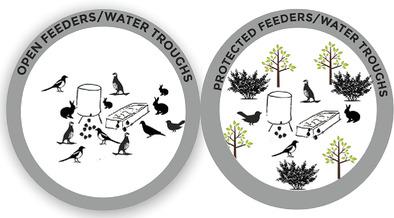当前位置:
X-MOL 学术
›
Integr. Zool.
›
论文详情
Our official English website, www.x-mol.net, welcomes your
feedback! (Note: you will need to create a separate account there.)
Do non‐target species visit feeders and water troughs targeting small game? A study from farmland Spain using camera‐trapping
Integrative Zoology ( IF 3.5 ) Pub Date : 2020-11-04 , DOI: 10.1111/1749-4877.12496 José A. ARMENTEROS 1 , Jesús CARO 2 , Carlos SÁNCHEZ‐GARCÍA 1, 3 , Beatriz ARROYO 2 , José A. PÉREZ 1 , Vicente R. GAUDIOSO 1 , Emilio J. TIZADO 4
Integrative Zoology ( IF 3.5 ) Pub Date : 2020-11-04 , DOI: 10.1111/1749-4877.12496 José A. ARMENTEROS 1 , Jesús CARO 2 , Carlos SÁNCHEZ‐GARCÍA 1, 3 , Beatriz ARROYO 2 , José A. PÉREZ 1 , Vicente R. GAUDIOSO 1 , Emilio J. TIZADO 4
Affiliation

|
Provision of food and water is a widespread tool implemented around the world for the benefit of game and other wildlife, but factors affecting the use of food and water by non‐target species are poorly known. We evaluated visits to feeders and water troughs by non‐game species using camera‐traps in two separate areas of Spain. Feeders and water troughs were either “protected” (when surrounded by more than 50% of shrubs/forest) or “open” (in the opposite case). A total of 18 948 photos from 5344 camera‐trapping days depicted animals, and 75 species were identified. Feeders and water troughs were visited by target species (partridges and lagomorphs, 55.3% of visits) and non‐target species (44.7% of visits). Among the latter, corvids were the most common (46.1% of visits), followed by rodents (26.8%), other birds (23.6%, mainly passerines), columbids (1.9%), and other species at minor percentages. The highest proportion of visiting days to feeders and water troughs was from corvids (0.173) followed by other‐birds (0.109) and rodents (0.083); the lowest proportion was recorded for columbids (0.016). Use intensity and visit frequency of water troughs tripled that recorded in feeders, and visits to open feeders/troughs were approximately twice those to protected ones. In summary: feeders and water troughs targeting small game species are also used regularly by non‐target ones; they should be set close to cover to optimize their use by non‐target species that are not competitors of target species (though corvids may visit them); water availability should be prioritized where drought periods are expected.
中文翻译:

非目标物种是否会访问针对小型猎物的饲养者和水槽?来自西班牙农田的使用相机诱捕的研究
粮食和水的供应是在全世界范围内为猎物和其他野生动植物造福的一种广泛使用的工具,但是影响非目标物种利用粮食和水的因素鲜为人知。我们使用相机诱捕装置对西班牙两个不同地区的非游戏物种对饲养者和水槽的访问进行了评估。喂食器和水槽要么被“保护”(当被超过50%的灌木丛/森林包围),要么被“开放”(相反)。在5344个诱捕相机的日子里,共绘制了18948张照片,描绘出动物,并鉴定出75种。目标物种(part和兔形目,占55.3%)和非目标物种(访问数44.7%)对饲养者和水槽进行了访问。在后者中,最常见的是Corvids(占探访次数的46.1%),其次是啮齿动物(占26.8%),其他鸟类(占23.6%,主要是雀形目),lum(1.9%)和其他物种的比例很小。喂食者和水槽访问日的最大比例是来自Corvids(0.173),其次是其他鸟类(0.109)和啮齿动物(0.083);最低的比例记录为proportion(0.016)。水槽的使用强度和访问频率是进食者记录的三倍,对开放式进食器/食槽的访问约为受保护者的两倍。总结:针对小型猎物的馈线和水槽也经常被非目标物种使用。它们应该接近覆盖,以优化非目标物种竞争者的非目标物种的使用(尽管柯维人可能会拜访它们);在预计干旱期间,应优先提供水。喂食者和水槽访问日的最大比例是来自Corvids(0.173),其次是其他鸟类(0.109)和啮齿动物(0.083);最低的比例记录为proportion(0.016)。水槽的使用强度和访问频率是进食者记录的三倍,对开放式进食器/食槽的访问约为受保护者的两倍。总结:针对小型猎物的馈线和水槽也经常被非目标物种使用。它们应该接近覆盖,以优化非目标物种竞争者的非目标物种的使用(尽管柯维人可能会拜访它们);在预计干旱期间,应优先提供水。喂食者和水槽访问日的最大比例是来自Corvids(0.173),其次是其他鸟类(0.109)和啮齿动物(0.083);最低的比例记录为proportion(0.016)。水槽的使用强度和访问频率是进食者记录的三倍,对开放式进食器/食槽的访问约为受保护者的两倍。总结:针对小型猎物的馈线和水槽也经常被非目标物种使用。它们应该接近覆盖,以优化非目标物种竞争者的非目标物种的使用(尽管柯维人可能会拜访它们);在预计干旱期间,应优先提供水。最低的比例记录为proportion(0.016)。水槽的使用强度和访问频率是进食者记录的三倍,对开放式进食器/食槽的访问约为受保护者的两倍。总结:针对小型猎物的馈线和水槽也经常被非目标物种使用。它们应该接近覆盖,以优化非目标物种竞争者的非目标物种的使用(尽管柯维人可能会拜访它们);在预计干旱期间,应优先提供水。最低的比例记录为proportion(0.016)。水槽的使用强度和访问频率是进食者记录的三倍,对开放式进食器/食槽的访问约为受保护者的两倍。总结:针对小型猎物的馈线和水槽也经常被非目标物种使用。它们应该接近覆盖,以优化非目标物种竞争者的非目标物种的使用(尽管柯维人可能会拜访它们);在预计干旱期间,应优先提供水。非目标物种也经常使用针对小型猎物的饲养者和水槽;它们应该接近覆盖,以优化非目标物种竞争者的非目标物种的使用(尽管柯维人可能会拜访它们);在预计干旱期间,应优先提供水。非目标物种也经常使用针对小型猎物的饲养者和水槽;它们应该接近覆盖,以优化非目标物种竞争者的非目标物种的使用(尽管柯维人可能会拜访它们);在预计干旱时期,应优先提供水。
更新日期:2020-11-04
中文翻译:

非目标物种是否会访问针对小型猎物的饲养者和水槽?来自西班牙农田的使用相机诱捕的研究
粮食和水的供应是在全世界范围内为猎物和其他野生动植物造福的一种广泛使用的工具,但是影响非目标物种利用粮食和水的因素鲜为人知。我们使用相机诱捕装置对西班牙两个不同地区的非游戏物种对饲养者和水槽的访问进行了评估。喂食器和水槽要么被“保护”(当被超过50%的灌木丛/森林包围),要么被“开放”(相反)。在5344个诱捕相机的日子里,共绘制了18948张照片,描绘出动物,并鉴定出75种。目标物种(part和兔形目,占55.3%)和非目标物种(访问数44.7%)对饲养者和水槽进行了访问。在后者中,最常见的是Corvids(占探访次数的46.1%),其次是啮齿动物(占26.8%),其他鸟类(占23.6%,主要是雀形目),lum(1.9%)和其他物种的比例很小。喂食者和水槽访问日的最大比例是来自Corvids(0.173),其次是其他鸟类(0.109)和啮齿动物(0.083);最低的比例记录为proportion(0.016)。水槽的使用强度和访问频率是进食者记录的三倍,对开放式进食器/食槽的访问约为受保护者的两倍。总结:针对小型猎物的馈线和水槽也经常被非目标物种使用。它们应该接近覆盖,以优化非目标物种竞争者的非目标物种的使用(尽管柯维人可能会拜访它们);在预计干旱期间,应优先提供水。喂食者和水槽访问日的最大比例是来自Corvids(0.173),其次是其他鸟类(0.109)和啮齿动物(0.083);最低的比例记录为proportion(0.016)。水槽的使用强度和访问频率是进食者记录的三倍,对开放式进食器/食槽的访问约为受保护者的两倍。总结:针对小型猎物的馈线和水槽也经常被非目标物种使用。它们应该接近覆盖,以优化非目标物种竞争者的非目标物种的使用(尽管柯维人可能会拜访它们);在预计干旱期间,应优先提供水。喂食者和水槽访问日的最大比例是来自Corvids(0.173),其次是其他鸟类(0.109)和啮齿动物(0.083);最低的比例记录为proportion(0.016)。水槽的使用强度和访问频率是进食者记录的三倍,对开放式进食器/食槽的访问约为受保护者的两倍。总结:针对小型猎物的馈线和水槽也经常被非目标物种使用。它们应该接近覆盖,以优化非目标物种竞争者的非目标物种的使用(尽管柯维人可能会拜访它们);在预计干旱期间,应优先提供水。最低的比例记录为proportion(0.016)。水槽的使用强度和访问频率是进食者记录的三倍,对开放式进食器/食槽的访问约为受保护者的两倍。总结:针对小型猎物的馈线和水槽也经常被非目标物种使用。它们应该接近覆盖,以优化非目标物种竞争者的非目标物种的使用(尽管柯维人可能会拜访它们);在预计干旱期间,应优先提供水。最低的比例记录为proportion(0.016)。水槽的使用强度和访问频率是进食者记录的三倍,对开放式进食器/食槽的访问约为受保护者的两倍。总结:针对小型猎物的馈线和水槽也经常被非目标物种使用。它们应该接近覆盖,以优化非目标物种竞争者的非目标物种的使用(尽管柯维人可能会拜访它们);在预计干旱期间,应优先提供水。非目标物种也经常使用针对小型猎物的饲养者和水槽;它们应该接近覆盖,以优化非目标物种竞争者的非目标物种的使用(尽管柯维人可能会拜访它们);在预计干旱期间,应优先提供水。非目标物种也经常使用针对小型猎物的饲养者和水槽;它们应该接近覆盖,以优化非目标物种竞争者的非目标物种的使用(尽管柯维人可能会拜访它们);在预计干旱时期,应优先提供水。











































 京公网安备 11010802027423号
京公网安备 11010802027423号